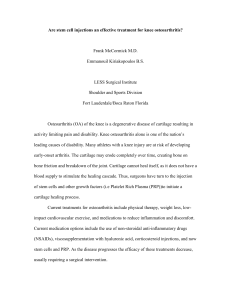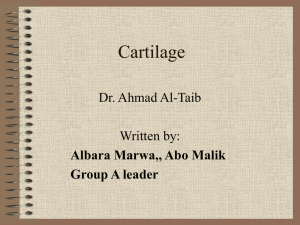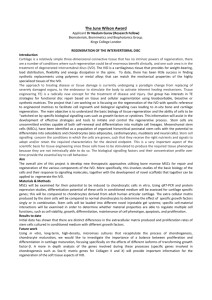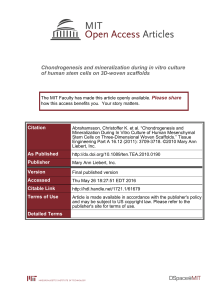PELLET CULTURE SYSTEM OF HUMAN STEM CELLS AS AN IN
advertisement
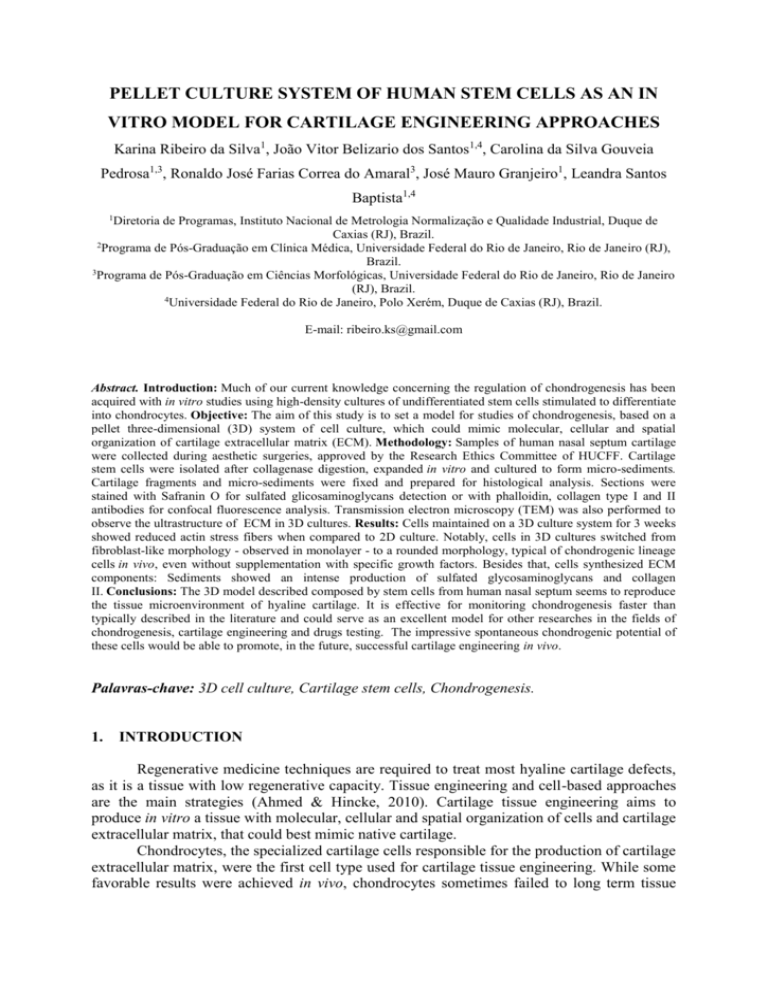
PELLET CULTURE SYSTEM OF HUMAN STEM CELLS AS AN IN VITRO MODEL FOR CARTILAGE ENGINEERING APPROACHES Karina Ribeiro da Silva1, João Vitor Belizario dos Santos1,4, Carolina da Silva Gouveia Pedrosa1,3, Ronaldo José Farias Correa do Amaral3, José Mauro Granjeiro1, Leandra Santos Baptista1,4 1 Diretoria de Programas, Instituto Nacional de Metrologia Normalização e Qualidade Industrial, Duque de Caxias (RJ), Brazil. 2 Programa de Pós-Graduação em Clínica Médica, Universidade Federal do Rio de Janeiro, Rio de Janeiro (RJ), Brazil. 3 Programa de Pós-Graduação em Ciências Morfológicas, Universidade Federal do Rio de Janeiro, Rio de Janeiro (RJ), Brazil. 4 Universidade Federal do Rio de Janeiro, Polo Xerém, Duque de Caxias (RJ), Brazil. E-mail: ribeiro.ks@gmail.com Abstract. Introduction: Much of our current knowledge concerning the regulation of chondrogenesis has been acquired with in vitro studies using high-density cultures of undifferentiated stem cells stimulated to differentiate into chondrocytes. Objective: The aim of this study is to set a model for studies of chondrogenesis, based on a pellet three-dimensional (3D) system of cell culture, which could mimic molecular, cellular and spatial organization of cartilage extracellular matrix (ECM). Methodology: Samples of human nasal septum cartilage were collected during aesthetic surgeries, approved by the Research Ethics Committee of HUCFF. Cartilage stem cells were isolated after collagenase digestion, expanded in vitro and cultured to form micro-sediments. Cartilage fragments and micro-sediments were fixed and prepared for histological analysis. Sections were stained with Safranin O for sulfated glicosaminoglycans detection or with phalloidin, collagen type I and II antibodies for confocal fluorescence analysis. Transmission electron microscopy (TEM) was also performed to observe the ultrastructure of ECM in 3D cultures. Results: Cells maintained on a 3D culture system for 3 weeks showed reduced actin stress fibers when compared to 2D culture. Notably, cells in 3D cultures switched from fibroblast-like morphology - observed in monolayer - to a rounded morphology, typical of chondrogenic lineage cells in vivo, even without supplementation with specific growth factors. Besides that, cells synthesized ECM components: Sediments showed an intense production of sulfated glycosaminoglycans and collagen II. Conclusions: The 3D model described composed by stem cells from human nasal septum seems to reproduce the tissue microenvironment of hyaline cartilage. It is effective for monitoring chondrogenesis faster than typically described in the literature and could serve as an excellent model for other researches in the fields of chondrogenesis, cartilage engineering and drugs testing. The impressive spontaneous chondrogenic potential of these cells would be able to promote, in the future, successful cartilage engineering in vivo. Palavras-chave: 3D cell culture, Cartilage stem cells, Chondrogenesis. 1. INTRODUCTION Regenerative medicine techniques are required to treat most hyaline cartilage defects, as it is a tissue with low regenerative capacity. Tissue engineering and cell-based approaches are the main strategies (Ahmed & Hincke, 2010). Cartilage tissue engineering aims to produce in vitro a tissue with molecular, cellular and spatial organization of cells and cartilage extracellular matrix, that could best mimic native cartilage. Chondrocytes, the specialized cartilage cells responsible for the production of cartilage extracellular matrix, were the first cell type used for cartilage tissue engineering. While some favorable results were achieved in vivo, chondrocytes sometimes failed to long term tissue maintenance in vivo, besides being difficult to expand and culture these cells in vitro, because dedifferentiation occurs (Salgado et al., 2006). Unlike terminally differentiated cells, adult stem cells are defined by self-renew capacity and potential to differentiate into mature cells (Reya et al., 2001). For cartilage tissue engineering, mesenchymal stem cells from bone marrow and adipose tissue seems to be good candidates, as they exhibit chondrogenic potential under inducing stimuli in vitro (Pittenger et al., 1999; Zuk et al, 2001). Although chondrogenic differentiation has been shown in monolayer culture, 3D structures, where cells acquire a spherical morphology, better mimic mesenchymal condensation, one of the primary events of chondrogenic differentiation (Johnstone et al, 1998). On the other hand, it has been reported that chondrogenic differentiation of mesesenchymal stem cells usually results in a significant proportion of fibrocartilage (Steck et al., 2005). Stem cells from cartilage is advantageous because of their high chondrogenic potential. However many issues concerning autologous hyaline cartilage cell source still exists, as this tissue is not in abundance to be collected without jeopardizing tissue function. Our group have recently isolated stem cells from negligible nasal septum cartilage fragments obtained by aesthetic surgery procedures, with spontaneous cartilage differentiation potential (Amaral et al., 2012). The use of chondrogenic cells is advantageous due to this spontaneous chondrogenic potential, but adipose mesenchymal stem cells are very attractive for medicine regenerative as this tissue is abundant and easily accessed by lipoaspiration procedures (Casteilla et al, 2005). However, there is no consensus in the scientific literature about the chondrogenic potential of these and other stem cells to form a completely cartilage construct. Therefore, it is necessary to set a standard model of chondrogenesis, which could support differentiation potential comparisons. Many strategies are available to induce chondrogenesis in vitro, like micromass culture, pellet culture and association with some scaffolds as alginate (Seda Tigli et al., 2009). Pellet cultures provide a microenvironment similar to that found in micromass cultures (Bobick et al, 2009). These pellet cultures are simple to produce and have experimental conditions easy to control, making them a good tool to investigate molecular issues involved in chondrogenesis (Muraglia et al, 2003). Using high-density cultures of undifferentiated cells stimulated to differentiate into chondrocytes, researchers have described many issues concerning the regulation of cartilage formation (Bobick et al, 2009). Although molecular analysis shows a initial differentiation to chondrogenesis, it does not certify the quality of the tissue constructed. On the other hand, histological and quantitative biochemaical assays could better evaluate the extracellular matrix production and organization (Kunisaki et al., 2007). The aim of this research is to set a model for studies of chondrogenesis, based on a pellet three-dimensional (3D) system of cell culture, which could best mimic hyaline cartilage extracellular matrix and be used as a standard for chodrogenic differentiation studies and drug testing. 2. MATERIALS AND METHODS Human cartilage Cartilage fragments from nasoseptal were obtained from healthy donors from 25 to 40 years old (n=3), that underwent aesthetic surgery procedures, under approval of the Research Ethics Committee of the Clementino Fraga Filho University Hospital, Federal University of Rio de Janeiro, Brazil. Isolation and culture of chondrogenic cells Chondrogenic cells were isolated as described previously (Amaral et al, 2012). Briefly, small fragments of cartilage were digesteded with collagenase 1A (Sigma Chemical Co) under shaking at 37°C for two hours. Cells were harvested by centrifugation and plated in tissue culture flasks with alpha-minimum essential medium (alpha-MEM, Sigma) containing 10% fetal bovine serum (FBS, LGC), 100 U/mL penicillin, and 100 μg/mL streptomycin. Cultures were maintained in a humid atmosphere with 5% CO2 at 37°C, and the medium was changed every 3–5 days until cell monolayer reached confluence. At nearly 90% confluence, cells were harvested with 0.125% trypsin (Gibco) 0.78mM EDTA (Gibco) and re-seeded at a density of 104 cells/cm2. Dissociation with trypsin followed by re-seeding for cell expansion was denominated “passage”. Experiments were performed with cells at second passage. Three- dimensional pellet culture Aliquots of 2x105 cells were centrifuged at 300g for 10 min in 15mL conical polypropylene tubes to form a pellet. Pellets were cultivated with a serum-free medium consisting of alfa-MEM supplemented with 6.25μg/mL insulin, 6.25μg/mL transferrin, 1.25μg/mL of bovine serum albumin (BSA, - Sigma), 50μg/mL ascorbic acid (all reagents from Sigma). Culture medium was renewed twice per week, keeping the micromass intact up to 21 days of cultivation. Immunofluorescence for phalloidin was used to evaluate the actin cytoskeleton. Chondrogenesis was assessed histologically, by Safranin O staining and collagen type II detection by immunofluorescence. Immunofluorescence analysis Pellet samples (n=3) were fixed in 4% buffered paraformaldehyde and incubated with solutions of sacarose 15% and 30% for at least 6 hours each, for subsequent embedding in OCT compound (Sakura Finetek) and freezing. Cryosections of 10μm were obtained on a Leica C1850 cryostat and mounted on microscope slides. Antigen unmasking for type II collagen antibody was done by treatment with hyaluronidase (4800U/ml Sigma diluted with 0.025mM NaCl and 0.05M of acetic acid, pH 5) for 2 hours at room temperature followed by treatment with 0.4% pepsin (Sigma) diluted in10mM HCl for 30 min at 37°C. Blockade of unspecific binding of immunoglobulins were performed by incubating sections with 5% BSA, 5% of goat serum and 0.5% Triton X-100 (Sigma) in phosphate buffer saline for 1.5 h. Overnight incubation at 4°C with primary antibodies was done: type II collagen (1:50; Santa Cruz Biotech) or TRITC conjugated phalloidin (1:100; Invitrogen). Secondary antibody staining was performed for type II collagen antibody, using FITC conjugated anti-mouse IgG (1:200; Invitrogen) for 1 hour at room temperature. Nuclei were stained with Sytox (1:500) or TO-PRO3 (1:500; Invitrogen) for 10 minutes and slides were mounted in Vectashield (Vector Lab). Stained sections were examined under a confocal fluorescence microscope (Leica TCS SP5). Slides incubated only with the secondary antibody as used as negative control. Safaranin O- Fast green staining Detection of sulfated glicosaminoglicans was performed by safranin O staining. Pellet samples (n=3, each cell type) and cartilage tissue fragments were fixed in 10% buffered formaldehyde. Samples were dehydrated in graded ethanol (70%, 100%, 100%), cleared in xylol and embedded in paraffin (all from Vetec). Two sections of 5μm cut at 50-μm intervals on an American Optical microtome were stained with Safranin O (Sigma) to evaluate the glycosaminoglycan content. Briefly, sections were dewaxed in xylene, hydrated in ethanol (100%, 95%, 70%; 2 min each) and finally in distilled water for 3 min. Slides were immersed in a solution of 0.2% safranin O (Sigma) in 1% acetic acid for 10 min followed by rinsing in distilled water to remove excess dye. Sections were then counterstained with a solution of 0.04% Fast green (Sigma) in 0.2% acetic acid for15s and rinsed in distilled water. After drying on a filter paper, slides were rinsed in absolute ethanol until excess of fast green was removed. After 3 washes in xylene (3min each), slides were mounted with EntellanR and examined under an optical microscope (Leica cDMI 6000 B) equipped with Leica DFC 500 digital camera. Transmission Electron Microscopy For transmission electron microscopy analysis, pellet cultures (n=3) were fixed in 2.5% glutaraldehyde buffered with 0.1 M sodium cacodylate for 2 hours at room temperature and post fixed with 1% OsO4 in the same buffer for 30 minutes (all from Electron Microscopy Sciences). Dehydration was performed in graded acetone (Merck) and then pellets were embedded in the Epon resin (Electron Microscopy Sciences). Sections of 70nm were obtained on a ultramicrotome (EM UC6), being examined under a transmission electron microscope (FEI- Tecnai Spirit 12). 3. RESULTS AND DISCUSSION Chondrogenic cells cultivated in monolayer showed a fibroblastoid morphology (Fig. 1A), with a spindle-shaped actin cytoskeleton (Fig.1C). Cells maintained in the high cellular density pellet culture system for 3 weeks (Fig.1B) showed reduced actin stress fibers (Fig. 1D) comparing to 2D culture system, which is closer to a physiological model for efficient chondrogenesis evaluation. Switch from fibroblast-like morphology – observed in monolayer – to a rounded one was more evident by analyzing sections of pellet cultures stained for Safranin O/Fast Green (Fig. 2). After three weeks of 3D cultivation, cells acquired a morphology that resembles chondrocytes (Fig. 2A), as observed in native hyaline cartilage (Fig. 2 – insert in A). Besides that, Safranin O staining revealed the production of sulfated glicosaminoglicans by cells culture in the 3D system (Fig. 2). Pink to orange color shows the glicosaminoglican content of pellets after three weeks of cultivation even without addition of chondrogenic growth factors to the culture medium. Some areas showed a higher degree of differentiation than others (Fig. 2 A and B). Figure 1. Cell culture behavior of human chondrogenic cells from nasal septum cartilage. (A) Monolayer of chondrogenic cells cultured in the presence of 10% FBS. (B) Pellet culture of chondrogenic cells culture in serum-free medium. Phase contrast microscopy — objective magnification: 10X (A,B). Confocal laser scanning microscopy shows actin cytoskeleton on monolayer cultures - bar size, 25 μm (C) and on pellet cultures – bar size, 10μm (D). Red: TRITC-phalloidin labeled actin filaments; Green: Sytox labeled cell nuclei). Figure 2. Production of glicosaminoglicans evaluated by Safranin O staining. After 21 days of 3D culture, chondrogenic cells produced an extracellular matrix rich in sulfated glicosaminoglicans, revealed by Safranin O staining . (A) and (B) are representative areas of sections analyzed. (C) Image representative of cartilage tissue stained for safranin O as a positive control. Objective lens magnification: 10X. Transmission electron microscopy revealed that the extracellular matrix produced by cells of pellet cultures was also enriched in collagen (Fig. 3A,B), which formed fibers through the sediment. By immunolabeling, it was observed that this collagen content is enriched in collagen type II, typical of hyaline cartilage (Fig 3C). Collagen type I, typical of fibrocartilage, was less detected throughout the pellet (data not shown). Considering that mesenchymal stem cells (Johnstone et al., 1998; Estes et al., 2010) and dedifferentiated articular chondrocytes (Barbero at al., 2003) need to be cultured in a 3D system with chondrogenic growth factors (as TGF- s and BMPs) for a successful chondrogenic differentiation, it is impressive how nasoseptal chondrogenic cells adopts the full chondrogenic phenotype, without the use of such factors. This chondrogenic commitment makes these cells an advantageous product for tissue engineering approaches Figure 3. Synthesis of collagen by chondrogenic cells of human nasal septum cartilage. Collagen content observed by transmission electron microscopy analysis (A, B) showed to be enriched in collagen type II, detected by imunofluorescence (C). Arrows in (A) and (B) indicates collagen fibers. 4. CONCLUSIONS The high-density three-dimensional cell culture system described in this study, using chondrogenic cells isolated from human nasal septum cartilage, seems to reproduce the tissue microenvironment of hyaline cartilage. It showed a complete chondrogenic differentiation process, as cells switched from a fibroblastoid to an oval morphology, and an effective production of hyaline cartilage extracellular matrix components. Besides, this system provides a chondrogenic differentiation model with reduced both time and procedure costs, because it abrogates the need to add growth factors in the cell culture medium, like TGF-3. Therefore, it is suggested that the culture system proposed in the current study be considered as a model of cartilage formation in vitro that can lead to the development of novel cartilage tissue engineering strategies, by contributing to the knowledge of this complex tissue microenvironment. In addition, this system also represents an efficient model for drug testing, as it can be easily handled and could promptly respond to exogenous factors. REFERENCES Ahmed, T.A., Hincke, M.T. Strategies for articular cartilage lesion repair and functional restoration.TissueEng Part B Rev. 16, 305, 2010. Amaral, RJ, Pedrosa Cda S, Kochem MC, Silva KR, Aniceto M, Claudio-da-Silva C, Borojevic R, Baptista LS. Isolation of human nasoseptal chondrogenic cells: a promise for cartilage engineering. Stem Cell Res. Mar;8(2):292-9, 2012 Barbero, A., Ploegert, S., Heberer, M., Martin, I. Plasticity of clonal populations of dedifferentiated adult human articular chondrocytes. Arthritis Rheum. 48 (5), 1315-1325. 2003 Bobick, B.E., Chen, F.H., Le, A.M., Tuan, R.S. Regulation of the chondrogenic phenotype in culture. Birth Defects Res C Embryo Today. 87(4), 351-371, 2009 Casteilla L, Planat-Bénard V, Cousin B, Silvestre JS, Laharrague P, Charrière G, Carrière A, Pénicaud L. Plasticity of adipose tissue: a promising therapeutic avenue in the treatment of cardiovascular and blood diseases? Arch Mal Coeur Vaiss. 98: 922-6, 2005 Estes, B.T., Diekman, B.O., Gimble, J.M., Guilak, F. Isolation of adipose-derived stem cells and their induction to a chondrogenic phenotype. Nat Protoc. 5 (7), 1294- 1311. 2010 Johnstone, B., Hering, T.M., Caplan, A.I., Goldberg, V.M., Yoo, J.U.In vitro chondrogenesis of bone marrowderived mesenchymal progenitor cells.Exp Cell Res. 238,265, 1998. Kunisaki, S.M., Fuchs, J.R., Steigman, S.A., Fauza, D.O. A comparative analysis of cartilage engineered from different perinatal mesenchymal progenitor cells. Tissue Eng. 13, 2633, 2007. Muraglia, A., Corsi, A., Riminucci, M., Mastrogiacomo, M., Cancedda, R., Bianco, P., Quarto, R. Formation of a chondro-osseous rudiment in micromass cultures of human bone-marrow stromal cells. J Cell Sci. 116(Pt 14), 2949-2955, 2003 Pittenger, M.F.; Macray, A.M.; Stephen, C.B.; Jaiswal, R.K.; Douglas, R; Joseph, D.M.; Moorman, M.A.; Simonetti, D.W.; Craig, S.; Marshak, D. Multilineage potential of adult human mesenchymal stem cells. Science. v.284, n.5411, p.143-147, 1999. Reya T, Morrison SJ, Clarke MF, Weissman IL. Stem cells, cancer, and cancer stem cells. Nature. 414:105-11, 2001 Salgado AJ, Oliveira JT, Pedro AJ, Reis RL. Adult stem cells in bone and cartilage tissue engineering. Curr Stem Cell Res Ther. 1:345-64, 2006 SedaTigli, R., Ghosh, S., Laha, M.M, Shevde, N.K., Daheron, L., Gimble, J., Gumuşderelioglu, M., Kaplan, D.L. Comparative chondrogenesis of human cell sources in 3D scaffolds. J Tissue EngRegen Med. 3, 348, 2009. Steck, E., Bertram, H., Abel, R., Chen, B., Winter, A., Richter, W. Induction of intervertebral disc-like cells from adult mesenchymal stem cells. Stem Cells. 23 (3), 403-411, 2005 Zuk, P.A.; Zhu, M.; Mizuno, H.; Huang, B.S.J.; Futrell, J.W.; Katz, A.J.; Benhaim, P.; Lorenz, H.P.; Hedrick, M.H. Multilineage cells from human adipose tissue: Implications for cell-based therapies. Tissue Engineering. v.7, n.2, p211-228, 2001.




